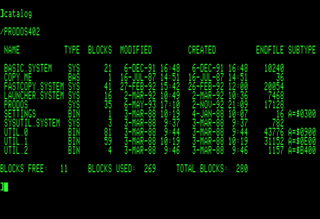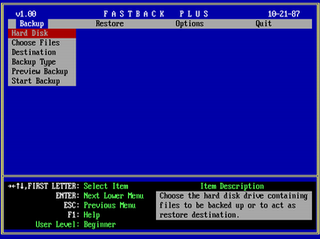
The Apple II series is a family of home computers, one of the first highly successful mass-produced microcomputer products, designed primarily by Steve Wozniak, manufactured by Apple Computer, and launched in 1977 with the original Apple II.

The Commodore 1581 is a 3½-inch double-sided double-density floppy disk drive that was released by Commodore Business Machines (CBM) in 1987, primarily for its C64 and C128 home/personal computers. The drive stores 800 kilobytes using an MFM encoding but formats different from the MS-DOS, Amiga, and Mac Plus formats. With special software it's possible to read C1581 disks on an x86 PC system, and likewise, read MS-DOS and other formats of disks in the C1581, provided that the PC or other floppy handles the "720 kB" size format. This capability was most frequently used to read MS-DOS disks. The drive was released in the summer of 1987 and quickly became popular with bulletin board system (BBS) operators and other users.

A floppy disk or floppy diskette is a type of disk storage composed of a thin and flexible disk of a magnetic storage medium in a square or nearly square plastic enclosure lined with a fabric that removes dust particles from the spinning disk. Floppy disks store digital data which can be read and written when the disk is inserted into a floppy disk drive (FDD) connected to or inside a computer or other device.
Hierarchical File System (HFS) is a proprietary file system developed by Apple Inc. for use in computer systems running Mac OS. Originally designed for use on floppy and hard disks, it can also be found on read-only media such as CD-ROMs. HFS is also referred to as Mac OS Standard, while its successor, HFS Plus, is also called Mac OS Extended.

ProDOS is the name of two similar operating systems for the Apple II series of personal computers. The original ProDOS, renamed ProDOS 8 in version 1.2, is the last official operating system usable by all 8-bit Apple II series computers, and was distributed from 1983 to 1993. The other, ProDOS 16, was a stop-gap solution for the 16-bit Apple IIGS that was replaced by GS/OS within two years.

SuperDrive is the product name for a floppy disk drive and later an optical disc drive made and marketed by Apple Inc. The name was initially used for what Apple called their high-density floppy disk drive, and later for the internal CD and DVD drive integrated with Apple computers. Though Apple no longer manufactures computers that feature built-in SuperDrives, the name is still used when referring to Apple's external CD and DVD drive accessory (pictured).

System 7 is the seventh major release of the classic Mac OS operating system for Macintosh computers, made by Apple Computer. It was launched on May 13, 1991, to succeed System 6 with virtual memory, personal file sharing, QuickTime, TrueType fonts, the Force Quit dialog, and an improved user interface.

Norton Utilities is a utility software suite designed to help analyze, configure, optimize and maintain a computer. The latest version of the original series of Norton Utilities is Norton Utilities 16 for Windows XP/Vista/7/8 was released 26 October 2012.
Distribution Media Format (DMF) is a format for floppy disks that Microsoft used to distribute software. It allowed the disk to contain 1680 KiB of data on a 31⁄2-inch disk, instead of the standard 1440 KiB. As a side effect, utilities had to specially support the format in order to read and write the disks, which made copying of products distributed on this medium more difficult. An Apple Macintosh computer running Disk Copy 6.3.3 on the Mac OS 7.6 or later operating system can copy and make DMF disks. The first Microsoft software product that uses DMF for distribution were the "c" revisions of Office 4.x. It also was the first software product to use CAB files, then called "Diamond".
PC Exchange, sometimes called File Exchange, was a utility program for Macintosh computers that allowed classic Mac OS to read floppy disks and other storage media with FAT formatting.
The Amiga computer can be used to emulate several other computer platforms, including legacy platforms such as the Commodore 64, and its contemporary rivals such as the IBM PC and the Macintosh.

The Disk II Floppy Disk Subsystem, often rendered as Disk ][, is a 5 +1⁄4-inch floppy disk drive designed by Steve Wozniak at the recommendation of Mike Markkula, and manufactured by Apple Computer, Inc. It went on sale in June 1978 at a retail price of US$495 for pre-order; it was later sold for $595 including the controller card and cable. The Disk II was designed specifically for use with the Apple II personal computer family to replace the slower cassette tape storage.
The Mac286 was an Intel 80286-based MS-DOS coprocessor expansion card for one of Apple Computer's first expandable Macintosh computers, the 1987 Macintosh II. It was developed by Phoenix Technologies under contract to Apple Computer and sold by AST Research in an effort to close the gap between the Macintosh and IBM PC computing worlds. AST also introduced the related Mac86 card for the Macintosh SE.
A self-booting disk is a floppy disk for home computers or personal computers that loads—or boots—directly into a standalone application when the system is turned on, bypassing the operating system. This was common, even standard, on some computers in the late 1970s to early 1990s. Video games were the type of application most commonly distributed using this technique.

FastBack is a software application developed in the late 1980s and early 1990s for backing up IBM PC and Macintosh computers. It was originally written by Fifth Generation Systems, a company located in Baton Rouge, Louisiana. When the company wanted to expand into the Apple market they purchased and rebranded a product from TouchStone Software Corporation.

A floppy disk is a disk storage medium composed of a thin and flexible magnetic storage medium encased in a rectangular plastic carrier. It is read and written using a floppy disk drive (FDD). Floppy disks were an almost universal data format from the 1970s into the 1990s, used for primary data storage as well as for backup and data transfers between computers.

The Macintosh External Disk Drive is the original model in a series of external 3+1⁄2-inch floppy disk drives manufactured and sold by Apple Computer exclusively for the Macintosh series of computers introduced in January 1984. Later, Apple would unify their external drives to work cross-platform between the Macintosh and Apple II product lines, dropping the name "Macintosh" from the drives. Though Apple had been producing external floppy disk drives prior to 1984, they were exclusively developed for the Apple II, III and Lisa computers using the industry standard 5+1⁄4-inch flexible disk format. The Macintosh external drives were the first to widely introduce Sony's new 3+1⁄2-inch rigid disk standard commercially and throughout their product line. Apple produced only one external 3+1⁄2-inch drive exclusively for use with the Apple II series called the Apple UniDisk 3.5.

The floppy disk is a data storage and transfer medium that was ubiquitous from the mid-1970s well into the 2000s. Besides the 3½-inch and 5¼-inch formats used in IBM PC compatible systems, or the 8-inch format that preceded them, many proprietary floppy disk formats were developed, either using a different disk design or special layout and encoding methods for the data held on the disk.

Mac OS is the series of operating systems developed for the Macintosh family of personal computers by Apple Computer, Inc. from 1984 to 2001, starting with System 1 and ending with Mac OS 9. The Macintosh operating system is credited with having popularized the graphical user interface concept. It was included with every Macintosh that was sold during the era in which it was developed, and many updates to the system software were done in conjunction with the introduction of new Macintosh systems.











